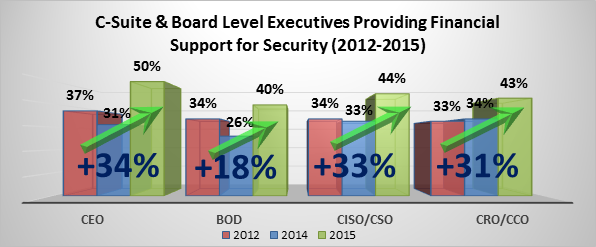
One of the services that EMA provides to the tech industry is research. During the course of the year, numerous projects are launched to help IT consumers and vendors understand market perceptions. EMA then provides analysis and forecasts on trends based upon those perceptions.
These projects have been continued in 2015. EMA has already had some significant research findings, some of which are from the Data-Driven Security Reloaded (DDSR) report. This report has had just over 200 respondents from North America for each of the multiple years it has been run. Each version has a different focus looking at how IT consumers in the SMB, mid-market, and enterprise spaces use technology and the data that is produced to improve their security posture. However, each version also has common threads so useful trend information can be gleaned.
The perceptions in this years’ DDSR report have the added benefit of being drawn post 2014, which was dubbed “the year of the breach.” A significant issue that arose in the year of the breach was the release/ dismissal/ resignation of executives such as CIOs and CEOs due to the failure to either stop breaches or effectively minimize their impacts. It was the perfect storm of numerous large scale data breaches and these unscheduled changes in leadership that caused security to get more attention at the executive level that security was getting more attention at the executive level. No company wants to lose hundreds of millions in revenue and no executives wants to lose his or her job, especially for something that he or she were unaware of.
The DDSR report is one of, if not the first of, the reports in 2015 to explore the conversational and financial attention being given to the issue of improving cybersecurity within the business. Below is the chart showing financial support for security at the C-level and above. It clearly shows that IT security personnel have gained support for driving the security program as a solution or service within the business rather than an insurance policy.
Respondents clearly indicated that they are gaining significantly higher attention and financial backing from the C-suite and their boards more than they have in any of the previous years. Financial support of security jumped between 31 and 34% from 2012 to 2015, and even more when looking at 2014 to 2015. The Boards of Directors even boosted financial support of security 18% over 2012 and nearly 54% over the 1Q 2014 research. (See embedded graphic for details.)
Given these numbers, I am really looking forward to see how well security fairs in 2015. Organizations are not out of the woods yet. We are bound to see more large breaches such as Anthem’s. It’s going to be a tough battle, but hopefully security will be able to slow the flow of private data into the hands of the cyber-criminals.
One of the services that EMA provides to the tech industry is research. During the course of the year, numerous projects are launched to help IT consumers and vendors understand market perceptions. EMA then provides analysis and forecasts on trends based upon those perceptions.
These projects have been continued in 2015. EMA has already had some significant research findings, some of which are from the Data-Driven Security Reloaded (DDSR) report. This report has had just over 200 respondents from North America for each of the multiple years it has been run. Each version has a different focus looking at how IT consumers in the SMB, mid-market, and enterprise spaces use technology and the data that is produced to improve their security posture. However, each version also has common threads so useful trend information can be gleaned.
The perceptions in this years’ DDSR report have the added benefit of being drawn post 2014, which was dubbed “the year of the breach.” A significant issue that arose in the year of the breach was the release/ dismissal/ resignation of executives such as CIOs and CEOs due to the failure to either stop breaches or effectively minimize their impacts. It was the perfect storm of numerous large scale data breaches and these unscheduled changes in leadership that caused security to get more attention at the executive level that security was getting more attention at the executive level. No company wants to lose hundreds of millions in revenue and no executives wants to lose his or her job, especially for something that he or she were unaware of.
The DDSR report is one of, if not the first of, the reports in 2015 to explore the conversational and financial attention being given to the issue of improving cybersecurity within the business. Below is the chart showing financial support for security at the C-level and above. It clearly shows that IT security personnel have gained support for driving the security program as a solution or service within the business rather than an insurance policy.

Figure <!–[if supportFields]> SEQ Figure \* ARABIC <![endif]–>1<!–[if supportFields]> <![endif]–>. C-Suite & Board Level executives providing financial support for security
Respondents clearly indicated that they are gaining signficantly higher attention and financial backing from the C-suite and their boards more than they have in any of the previous years. Financial support of security jumped between 31 and 34% from 2012 to 2015, and even more when looking at 2014 to 2015. The Boards of Directors even boosted financial support of security 18% over 2012 and nearly 54% over the 1Q 2014 research.
Given these numbers, I am really looking forward to see how well security fairs in 2015. Organizations are not out of the woods yet. We are bound to see more large breaches such as Anthem’s. It’s going to be a tough battle, but hopefully security will be able to slow the flow of private data into the hands of the cybercriminals.One of the services that EMA provides to the tech industry is research. During the course of the year, numerous projects are launched to help IT consumers and vendors understand market perceptions. EMA then provides analysis and forecasts on trends based upon those perceptions.
These projects have been continued in 2015. EMA has already had some significant research findings, some of which are from the Data-Driven Security Reloaded (DDSR) report. This report has had just over 200 respondents from North America for each of the multiple years it has been run. Each version has a different focus looking at how IT consumers in the SMB, mid-market, and enterprise spaces use technology and the data that is produced to improve their security posture. However, each version also has common threads so useful trend information can be gleaned.
The perceptions in this years’ DDSR report have the added benefit of being drawn post 2014, which was dubbed “the year of the breach.” A significant issue that arose in the year of the breach was the release/ dismissal/ resignation of executives such as CIOs and CEOs due to the failure to either stop breaches or effectively minimize their impacts. It was the perfect storm of numerous large scale data breaches and these unscheduled changes in leadership that caused security to get more attention at the executive level that security was getting more attention at the executive level. No company wants to lose hundreds of millions in revenue and no executives wants to lose his or her job, especially for something that he or she were unaware of.
The DDSR report is one of, if not the first of, the reports in 2015 to explore the conversational and financial attention being given to the issue of improving cybersecurity within the business. Below is the chart showing financial support for security at the C-level and above. It clearly shows that IT security personnel have gained support for driving the security program as a solution or service within the business rather than an insurance policy.

Figure <!–[if supportFields]> SEQ Figure \* ARABIC <![endif]–>1<!–[if supportFields]> <![endif]–>. C-Suite & Board Level executives providing financial support for security
Respondents clearly indicated that they are gaining signficantly higher attention and financial backing from the C-suite and their boards more than they have in any of the previous years. Financial support of security jumped between 31 and 34% from 2012 to 2015, and even more when looking at 2014 to 2015. The Boards of Directors even boosted financial support of security 18% over 2012 and nearly 54% over the 1Q 2014 research.
Given these numbers, I am really looking forward to see how well security fairs in 2015. Organizations are not out of the woods yet. We are bound to see more large breaches such as Anthem’s. It’s going to be a tough battle, but hopefully security will be able to slow the flow of private data into the hands of the cybercriminals.


